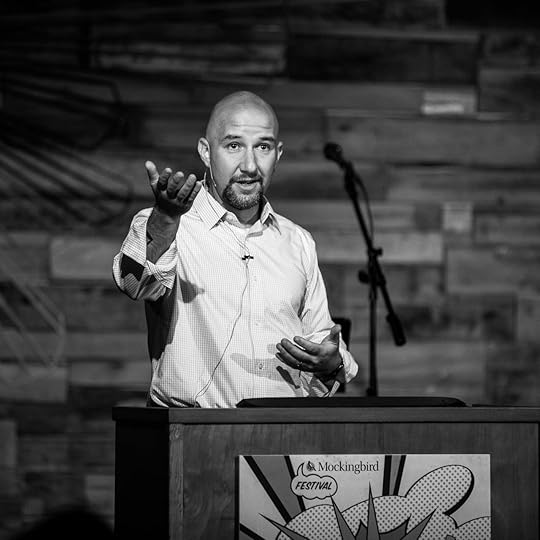Faith is the Threshold to All Knowledge

If you appreciate the work, pay it forward. Literally! Become a paid subscriber.
Our Monday Night Live group will meet again tonight at 7:00 EST to discuss Bonhoeffer’s “Lectures on Christology.” Subscribers will get an email and link shortly before we go live.
Here is the reading for tonight:
Bonhoeffer Reading 21.21MB ∙ PDF fileDownloadDownloadAnd here is my summary of its themes:
When it comes to proclamation, one of the dangers of glawspel— muddling the gospel with the law— is that it inevitably treats Jesus like a helpful add-on to the Christian life. Like the optional extras at a car dealership (heated seats, leather trim, a moonroof) Jesus is nice to have, but you can still drive off the lot without him.
Jesus is not your co-pilot.
“Jesus is my savior” does not even cut it.
Dietrich Bonhoeffer saw the whole of existence—your life, my life, the mess and beauty of history, the groaning of creation itself—as orbiting one singular, non-negotiable center: Jesus Christ. And for Bonhoeffer “Christ” denotes neither the projection of our best selves nor a religious concept but Christ in the flesh, crucified and risen.
The Jesus with calluses on his heels and holes in his hands is the center of all reality.
In his “Lectures on Christology,” Bonhoeffer says that Christ stands where you stand and— thank God— Christ stands where I cannot stand. Jesus is the hinge point between your old self (the one so good at self-justification and self-destruction, the one glawspel flatters so) and the new self you can’t make for yourself. Christ stands in our place, Bonhoeffer teachers, representing the boundary between our old and new self. That is, the law—God’s good and holy will—stands between the old and new Adam as fixed as a brick wall. On our own, depending only upon our own righteousness, it smashes us to pieces every time.
Christ does more than stand with us as we crash against the boundary that is the law. Christ takes the hit for us. He both becomes the law’s condemnation and its fulfillment, thereby opening a path through the boundary into newness of life.
Thus—
“Christ the Center” is neither sentimentality nor spirituality.
Bonhoeffer’s point is not psychological but ontological.
This is not about how you perceive the world around you. This is who you are before God. Christ is not one of the ways you find balance in life. Christ is the ground on which you stand— even if you don’t know it.
He is the one without whom there is no such thing as “you” at all.
In his lectures, Bonhoeffer then pans out, widening the horizon.
Christ is not just the center of my existence; he’s the hidden center of history. Bonhoeffer insists that history is messianic. History is not simply one damn thing after another, from elections to wars to American Eagle commercials to oncology appointments. Despite appearances, history is moving from promise to fulfillment.
It’s his story.
According to Bonhoeffer, at the heart of reality is the promise of God becoming God’s people, fulfilled in Christ. This means the cross is the judgment and the justification of the world’s powers, which, correlatively, makes the church as Christ’s Body the center of history.
The church is the center of this movement from promise to fulfillment, for it is the church where the state learns it is not God and the poor learn God is for them.
That we use the term nature rather than creation makes it difficult for us to speak Christian in Bonhoeffer’s terms. In nature, everything is already as it is ordered according to physical laws. But in creation, nothing is presently as God originally desired. Creation, Bonhoeffer says, reading St. Paul, is groaning under the curse of the fall.
Creation needs liberation.
Salvation includes all of creation just as much as it includes the creature you call you.
Much like Maximus the Confessor, Bonhoeffer sees Christ as the new creation in person. In Christ, nature’s servitude ends. Its future isn’t extinction but resurrection. Christ is the mediator not just between you and God, but between the world itself and God. And in the sacraments creation’s future breaks into the present. Ordinary creatures of water, wine, and bread become participants in the eschatological feast.
Christology is cosmic.
Christ will not remain merely the center.
Christ is becoming all things.
One of the invigorating aspects of Bonhoeffer’s Christology as it appears in these lectures is his refusal to distinguish the so-called Jesus of history from the Christ of faith. Such a distinction, he argues, is impossible. You can neither prove nor disprove the resurrection by historical research. Rather, faith in the risen Christ is what opens the door to the historical Jesus. It does not matter what original document you posit behind the Gospel of Mark, without Easter faith, you will never find Mary’s boy and Pilate’s victim.
This is a bold move.
Bonhoeffer inverts our logical expectations. He says our access to the historical Christ is through the resurrection not the other way around. It is not the case that first you prove historically that Jesus existed and then you add faith to this knowledge.
Faith is threshold to all knowledge.
In his lectures, Bonhoeffer addresses an ancient heresy that is never far from the church: docetism— the notion that Jesus merely appeared to be human. Bonhoeffer understands the temptation, for a God who only looks human is so much easier to handle much less comprehend. A God who has a mother and an executioner is an impossible paradox; nevertheless, docetism guts the gospel.
If Christ is not fully human, he cannot redeem humanity.
The early Church smelled the danger and condemned it. Bonhoeffer agrees. Only as one of us can Christ be completely for us.
Back to the starting point—
With his emphasis on Christ as the Center, Bonhoeffer is eschewing any reductions of the gospel that render Jesus into a mere accessory to our lives. If Christ is the Center of your existence, then you do not have a life apart from him. Thus, any understanding of your life without him is an aberration.
If Christ is the Center of your life, then he’s already got you before you knew to look for him.
If Christ is the Center of history, then every headline is provisional, relative to cross and empty tomb.
If Christ is the Center of nature, then the redemption story includes more than you and me, every eucharistic loaf is a preview of wheat and soil and sun brought to their fulfillment.
Admittedly, these lectures are denser than I recalled, but Bonhoeffer’s point is nonetheless uncomfortably clear.
Christ doesn’t fit into your life.
Your life is hidden with Christ in God.
All things are hidden with Christ in God.
And if that’s true, then everything—everything—is re-centered.
 Get more from Jason Micheli in the Substack appAvailable for iOS and AndroidGet the app
Get more from Jason Micheli in the Substack appAvailable for iOS and AndroidGet the app
Jason Micheli's Blog
- Jason Micheli's profile
- 13 followers



